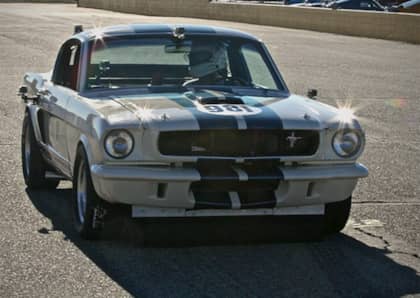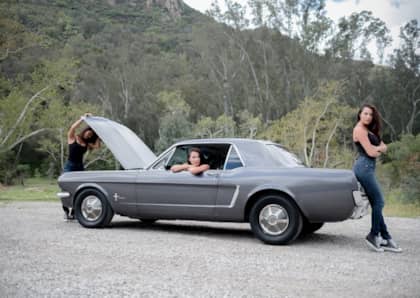Chasing Ponies Down South: A Classic Car Tale
My father was a Chevy man. And then he was a Ford man. I have no idea why he changed his religion. Maybe it was the Chevy Vega that did it. Who knows?
As for me, I’m not a Chevy or a Ford. I’m just a car guy. I don’t care what kind of emblem is stuck on the front of it. If it’s got four wheels and a steering wheel, I’ll drive it and, more than likely, I’ll try to figure out some way to make it drive better. In my mind, every car is a project car. There’s no fun in owning something that’s perfect right out of the box. A car isn’t really mine until I’ve stripped a few bolts and busted a few knuckles on it. It’s not owning a car that’s fun, it’s making a better car that really gets me going. That’s what really defines a car guy or car gal.
And like most car folk, no matter how many luxuries and digital bells and whistles newer cars have, there reaches a point when you just want to go old school. You want to get your hands on something made of steel and chrome and has no idea what a catalytic converter is. Something that vibrates the fillings in your teeth when it idles. Something that’s American and loud and…well, you get the idea.

(Photos: Jason Mott & Caitlin Andrews)
When I was a boy my father had a 1967 Chevelle Malibu. Deepwater blue. It was the greatest car I’d ever known. Maybe it still is now that my dad’s passed away.
I’ve spent the last few years trying to find a Malibu of my own as a project car. The problem is that a Malibu project car is a bit hard to get your hands on. The few you find on the market are either rusted out hulks or matching-numbers-restored trailer queens, the owners of which not only want an arm and a leg and your firstborn child, but thirty-percent of any and all future extremities and beloved offspring.
The classic car market can be brutal sometimes. Especially if you’re looking for a specific model and year and aren’t financed like Bill Gates. So at some point this spring when I got the resto-mod itch, I admitted to myself that I wasn’t a millionaire — imagine my surprise and then sadness — and that what I needed to do was stop looking for the exact car I wanted, for now at least, and start looking for a car I could have fun building.

For those of you who don’t know, I live in the South. The bottom right corner of North Carolina to be exact. It’s farm country populated with a few swamps and lakes that people pass through on their way to the beach.
Finding an old car in Swamp/Beach Country is a tricky business. You can’t get away from rust. No matter how good a car you find looks, no matter how rust-free it may seem — whether it rolled off the assembly line five years ago or fifty years ago — you’re going to have to deal with rust. Down south, finding a project car is about deciding how much rust you want to eat with your biscuits and gravy each morning.
I did what most people do nowadays and spent some time poking around online. I checked the usual sites, hoping to come across some amazing deal that everyone else had overlooked. But that came up empty. There were no deals and, even more than that, I’m just too old fashioned to buy a car without being able to lay my hands on the steel first. So I waited and kept my eyes open.
Then a few months back on my way home from my girlfriend’s house I came across a 1971 Ford Mustang with a "for sale" sign hanging in the front window like a new tooth. The Mustang was a faded black color with a nice pinstripe running down the side. No dents, no dings. All in all, it wasn’t bad. So I got a little excited, like a kid who’s gotten a peek at their Christmas gift while covertly snooping through Mom and Dad’s closet.
But, when I pulled up and finally got a good look at the car, I immediately knew it wasn’t for me. The Mustang — which had some damn fine body lines — also happened to have a rollcage installed in it. Now, I’ve got nothing against rollcages. Fact of the matter is I’m a fan of both cars fast enough to warrant a rollcage and of the safety rollcages afford. But, I also know that you can tell a lot about what kind of life a car’s led based on what type of aftermarket changes have happened to it. And one thing I know for sure is that any car with a rollcage has led a hard life.

A rollcage means the engine’s been driven hard and probably fed a consistent diet of ever-increasing horsepower, which means the transmission and driveline has also been force fed those same increases in horsepower. And when all of those things start adding up, you have to know a lot about the person who did the work to know whether or not that work was done right. Nobody wants to buy anyone else’s shoddy work. The last thing I wanted was to get the car home only to watch the rear end fall out onto the highway because Johnny Owner never got around to upgrading the differential and ground it into peanut butter just before selling it.
To make matters worse, there was a good coating of rust chewing through not only the quarter panels but, more importantly, the subframe. Yeah, all of that could be fixed, but that meant more money, time and headaches. I wanted a fixer-upper, not a fixer-everythinger. So, I left that one behind. But, I most definitely had the itch. So I sent out the old Bat-signal and started asking around to my friends. You know the line: “You know anybody with an old car they want to sell?”

All I knew for certain was that I wanted an American muscle car. Mopar, Ford, Chevy…it didn’t matter to me. I had an idea of a fast, agile resto-mod car in my head and the shape of the thing didn’t particularly matter to me. I just wanted to take an old piece of metal and refine it until it could carve up these windy, back woods, North Carolina roads better than anything this side SEMA. Luckily, I didn’t have to wait too long.
A college friend named Ramsey got in touch with me saying that she had a 1966 Mustang Coupe that she needed to get rid of. She loved the car, but she and her husband had a family now and the car, which didn’t run anymore, was taking up valuable garage space that could be used to hold toys, strollers — all that usual stuff.

I went over on a Saturday afternoon to check out the Signal Flare Red colored piece of Americana. Outside of car shows, you don’t see many classic cars on the road. We drive every day and get used to the lines and angles that make up cars the modern cars. But standing in front of that old Mustang, I was able to see why those cars age without ever getting older.
A first-generation Mustang truly is a piece of artwork. All those long, clean lines. That perfect flatness that somehow curves in just the right places. The car has a look of both practicality and economy, while still hinting at a secret desire to meet you on the playground and steal your lunch money. It’s a car that can be either a lazy loafer or the barbarian who rages at the castle’s front gate. In short, it was everything I wanted in a car.

And the best part was that it had been garage kept its entire life, so the dreaded rust that plagues cars in the American South was kept to a minimum. My friend took time to warn me about the presence of Bondo on the rear quarter panel, but I shrugged that off and kept my focus on the frame of the car. That’s where rust is truly dangerous. And, thankfully, it turned out to be rust free.

A week later a tow truck appeared and my new 1966 Mustang rolled off the back and found me grinning like a schoolboy. I always give my project cars names. My BMW M3 that I retooled the suspension and brakes on I named “Project Ocktoberfest.” The 1996 Mazda Miata that I dropped a Honda S2000 engine into, I named “Project Cooked Sushi.” And now, the first-generation Mustang for which I’ve planned chassis stiffening, brake overhauls, suspension redux and, perhaps most important, an engine and transmission swap, I’ve nicknamed “Project Robo-Horse.”
It’s a dumb name, I know. But it’s a fun name. And project cars were always meant to be fun.

Editor’s note about the author: Jason Mott is a New York Times best-selling novelist whose debut novel, The Returned, spawned the ABC show Resurrection. Jason's been a car and racing junkie ever since Petter Solberg flipped his first Subaru. When he's not banging knuckles and stripping lug nuts, he's visiting racetracks, writing books, bandaging the aforementioned knuckles and eating Twizzlers by the fistful.











